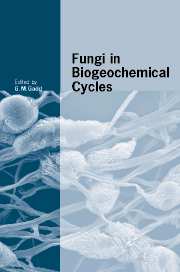Book contents
- Frontmatter
- Contents
- List of Contributors
- Preface
- 1 Geomicrobiology: relative roles of bacteria and fungi as geomicrobial agents
- 2 Integrated nutrient cycles in boreal forest ecosystems – the role of mycorrhizal fungi
- 3 Fungal roles in transport processes in soils
- 4 Water dynamics of mycorrhizas in arid soils
- 5 Integrating ectomycorrhizal fungi into quantitative frameworks of forest carbon and nitrogen cycling
- 6 Role of arbuscular mycorrhizal fungi in carbon and nutrient cycling in grassland
- 7 The role of wood decay fungi in the carbon and nitrogen dynamics of the forest floor
- 8 Relative roles of bacteria and fungi in polycyclic aromatic hydrocarbon biodegradation and bioremediation of contaminated soils
- 9 Biodegradation and biodeterioration of man-made polymeric materials
- 10 Fungal dissolution and transformation of minerals: significance for nutrient and metal mobility
- 11 Fungal activities in subaerial rock-inhabiting microbial communities
- 12 The oxalate–carbonate pathway in soil carbon storage: the role of fungi and oxalotrophic bacteria
- 13 Mineral tunnelling by fungi
- 14 Mineral dissolution by ectomycorrhizal fungi
- 15 Lichen biogeochemistry
- 16 Fungi in subterranean environments
- 17 The role of fungi in carbon and nitrogen cycles in freshwater ecosystems
- 18 Biogeochemical roles of fungi in marine and estuarine habitats
- Index
- References
6 - Role of arbuscular mycorrhizal fungi in carbon and nutrient cycling in grassland
Published online by Cambridge University Press: 10 December 2009
- Frontmatter
- Contents
- List of Contributors
- Preface
- 1 Geomicrobiology: relative roles of bacteria and fungi as geomicrobial agents
- 2 Integrated nutrient cycles in boreal forest ecosystems – the role of mycorrhizal fungi
- 3 Fungal roles in transport processes in soils
- 4 Water dynamics of mycorrhizas in arid soils
- 5 Integrating ectomycorrhizal fungi into quantitative frameworks of forest carbon and nitrogen cycling
- 6 Role of arbuscular mycorrhizal fungi in carbon and nutrient cycling in grassland
- 7 The role of wood decay fungi in the carbon and nitrogen dynamics of the forest floor
- 8 Relative roles of bacteria and fungi in polycyclic aromatic hydrocarbon biodegradation and bioremediation of contaminated soils
- 9 Biodegradation and biodeterioration of man-made polymeric materials
- 10 Fungal dissolution and transformation of minerals: significance for nutrient and metal mobility
- 11 Fungal activities in subaerial rock-inhabiting microbial communities
- 12 The oxalate–carbonate pathway in soil carbon storage: the role of fungi and oxalotrophic bacteria
- 13 Mineral tunnelling by fungi
- 14 Mineral dissolution by ectomycorrhizal fungi
- 15 Lichen biogeochemistry
- 16 Fungi in subterranean environments
- 17 The role of fungi in carbon and nitrogen cycles in freshwater ecosystems
- 18 Biogeochemical roles of fungi in marine and estuarine habitats
- Index
- References
Summary
Introduction
Arbuscular mycorrhizal fungi (AMF) are the most ancient, widespread and ubiquitous of all the groups of mycorrhiza: they have a global distribution in widely contrasting plant communities including the Tropics, the Boreal forest, arctic tundra and all types of grassland. Considerable effort has been made in recent years in order to set AMF within a robust phylogeny. Recent advances in molecular biological techniques have enabled scientists to place AMF in a new division, the Glomeromycota. At present, this division contains only about 150 species, which is remarkable given the enormous number of plant species the fungi readily colonize. The mutualistic symbioses that AMF form with their host plants give rise to a number of important benefits to both the plant and fungus. A brief glance at a standard mycorrhizal text will list many ecologically important attributes, such as improved disease resistance, water uptake, nutrient transfer and the ability of the fungus to be a major sink for photosynthate. Indeed, the importance of AMF for nutrient uptake and carbon allocation has been recognized for decades. The ability of AMF (and other mycorrhizal types) to utilize recent plant photosynthate and thus have access to a near continuous supply of energy immediately gives them a potential advantage over saprotrophic micro-organisms, which are forced to obtain their energy in the highly carbon-limited heterogeneous soil environment.
- Type
- Chapter
- Information
- Fungi in Biogeochemical Cycles , pp. 129 - 150Publisher: Cambridge University PressPrint publication year: 2006
References
- 3
- Cited by



